
Tadeáš Hájek z Hájku, also known as Tadeáš Hájek of Hájek, Thaddaeus Hagecius ab Hayek or Thaddeus Nemicus, was a Czech naturalist, personal physician of the Holy Roman Emperor Rudolph II and an astronomer in the Kingdom of Bohemia.
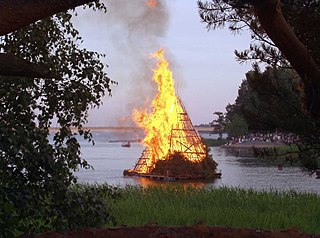
Seurasaari is an island and a district in Helsinki, Finland, known mostly as the location of the Seurasaari Open-Air Museum, which consists of old, mainly wooden buildings transplanted from elsewhere in Finland and placed in the dense forest landscape of the island.
Markus Niemelä is a Finnish former race car driver. He was the 2008 series champion after winning the final round at Road Atlanta. His international racing career has been volatile due to a number of injuries he has sustained during his career.

The West Papuan lorikeet is a species of parrot in the family Psittaculidae. It is found in New Guinea. Its natural habitat is subtropical or tropical moist montane forests.
The 2008 Atlantic Championship season was the thirty-fifth Atlantic Championship season. It began on April 20, 2008 and ended on October 4, 2008. Despite the merger of Champ Car's premier series with the Indy Racing League, the Champ Car owners continued to own and operate the Atlantic Championship under a new legal entity, Atlantic Racing Series, LLC. Champ Car continued to sanction the first two events of the season at Long Beach and Laguna Seca with the remainder of the season running under IMSA sanction. The Cooper Tires Presents the Atlantic Championship Powered by Mazda Drivers' Champion was Markus Niemelä driving for Brooks Associates Racing.

Stella's lorikeet is a species of parrot in the family Psittaculidae. It is endemic to New Guinea. Its natural habitat is subtropical or tropical moist montane forests.
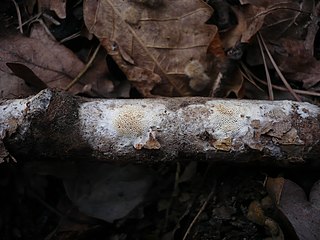
Ceriporiopsis is a genus of fungi in the family Phanerochaetaceae. The genus is widely distributed, and, according to a 2008 estimate, contains about 25 species. Ceriporiopsis was circumscribed in 1963 by Polish mycologist Stanislaw Domanski. The genus is a wastebasket taxon, containing "species that share common macroscopic and microscopic characteristics, but are not necessarily related." Ceriporiopsis species are crust fungi that cause a white rot. They have a monomitic hyphal system, containing only generative hyphae, and these hyphae have clamp connections.
Gelatoporia is a fungal genus in the family Gelatoporiaceae. This is a monotypic genus, containing the single widely distributed species Gelatoporia subvermispora. The genus was circumscribed in 1985 by Finnish mycologist Tuomo Niemelä to contain poroid crust fungi with a monomitic hyphal structure, clamped hyphae, and producing white rot.

Skeletocutis is a genus of about 40 species of poroid fungi in the family Polyporaceae. The genus has a cosmopolitan distribution, although most species are found in the Northern Hemisphere. It causes a white rot in a diverse array of woody substrates, and the fruit bodies grow as a crust on the surface of the decaying wood. Sometimes the edges of the crust are turned outward to form rudimentary bracket-like caps.
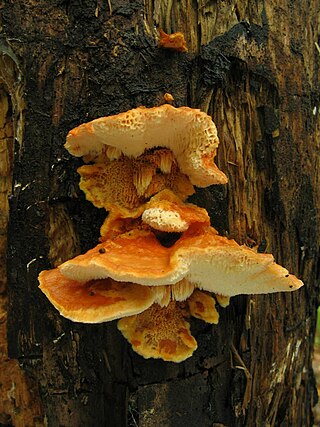
In Finland, Kotiranta and Niemelä introduced a widely used method for comparing the conservation values of different forest areas, based on the observation that certain wood-rotting fungi are very sensitive to the impact of human activities on forest ecosystems. Such species are slow to return to areas from where they have disappeared, so their presence is evidence of a long continuity in forest ecosystems.
Skeletocutis borealis is a rare species of poroid fungus in the family Polyporaceae. Found in northern Europe, it was described as new to science in 1998 by Finnish mycologist Tuomo Niemelä.
Skeletocutis brevispora is a species of poroid crust fungus in the family Polyporaceae. It was described as new to science in 1998 by Finnish mycologist Tuomo Niemelä.
Skeletocutis brunneomarginata is a species of poroid crust fungus in the family Polyporaceae. Found in the United States, it was described as new to science in 2007 by Norwegian mycologist Leif Ryvarden. He collected the type in Bent Creek Experimental Forest, North Carolina in 2004. The fungus is very similar in appearance to Skeletocutis kühneri, but with a brown margin and subiculum. S. brunneomarginata is one of 14 Skeletocutis species that occurs in North America.

Skeletocutis chrysella is a species of poroid crust fungus in the family Polyporaceae. Found primarily in Northern Europe, it has a boreal distribution, and has also been collected in East Karelia, Yakutia, and North America. It is classified as a vulnerable species on the Norwegian Red list, where it is considered to be declining.
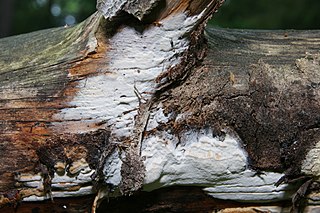
Flavidoporia pulvinascens is a species of crust fungus that is found in Europe. Czech mycologist Albert Pilát originally described the fungus in 1953 as a species of Poria.
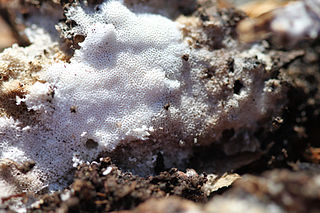
The Gelatoporiaceae are a small family of crust fungi in the order Polyporales. The family was circumscribed in 2017 by mycologists Otto Miettinen, Alfredo Justo and David Hibbett to contain the type genus Gelatoporia and three other related genera, Cinereomyces, Obba, and Sebipora.
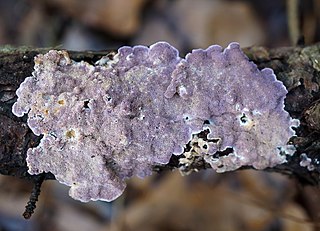
Skeletocutis lilacina is a species of poroid fungus in the family Polyporaceae. Originally found in Switzerland, it was described as a new species in 1984 by mycologists Alix David and Jean Keller. It has also been reported from North America.
Skeletocutis substellae is a species of poroid crust fungus in the family Polyporaceae. Found in China, it was described as new to science in 2011 by mycologist Yu-Cheng Dai. The holotype specimen was collected in Hainan, was it was found growing on the rotting wood of Dacrydium elatum. Spores of the fungus are allantoid, translucent, thin-walled, and smooth, typically measuring 2.8–3.5 by 0.7–1 µm. S. substellae was named for its similarity to S. stellae. Differences from this latter fungus include swollen skeletal hyphae when mounted in a solution of potassium hydroxide, and smaller spores.
Skeletocutis friata is a rare species of poroid crust fungus in the family Polyporaceae. Found in Finland, it was first described as a new species in 1998 by Tuomo Niemelä and Reima Saarenoksa, with the name Skeletocutis friabilis. It was given the epithet friata three years later, after it was discovered that a tropical Asian species had already been given the name Skeletocutis friabilis, with a publication date two months prior to theirs. The holotype was collected by Saarenoksa in Sipoo, southern Finland, where it was found growing on the bark and exposed wood of a fallen twig of common alder. The authors later noted that subsequent searching of the type locality, as well as other locations in southern Finland, failed to turn up additional examples of this species.
Skeletocutis papyracea is a species of poroid crust fungus in the family Polyporaceae. It was described as new to science by Alix David in 1982. The type was collected in France, where it was found growing on a fallen trunk of Scots pine. The fungus was reported in northeastern China in 2005, and in Lithuania in 2013. A microscope is useful for identification of this fungus: it differs from other Skeletocutis by the fact that its skeletal hyphae dissolve in 5% KOH solution.











